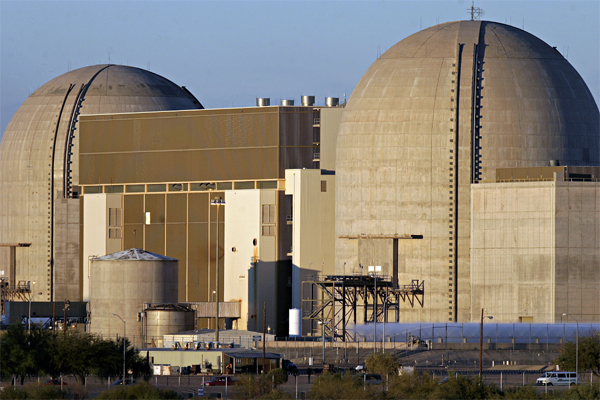
By Liam Denning
Once again, we are on the cusp of a nuclear renaissance. Actually realizing one requires something nuclear power isn’t known for: Speed.
Nuclear plants produce carbon-free power, don’t rely on fossil fuels subject to bad stuff like European wars, and run at high capacity factors. Hence, in these troubled, climate-conscious times, the renewed interest. As it is, the US hosts the world’s largest fleet, generating 18% of the country’s electricity overall and almost half of its zero-carbon electricity. The vast majority were built in two waves through the 1970s and 1980s, with an average age of 36 years.
There are two sides to a mooted renaissance.One is a new lease on life for existing plants. More than 10 reactors have closed over the past decade, largely because cheap shale gas depressed the price of electricity and burgeoning renewables also muscled in. Moreover, nuclear power’s attribute of zero-emissions largely went unrewarded, given a paucity of incentives.

All that has changed. Gas prices hit their highest level in 14 years this summer and 2023 electricity futures in the mid-Atlantic region, for example, are up more than 50% since January. Several states, such as New Jersey and Illinois, instituted subsidies after a game of chicken, with plant operators threatening to shut down. The Inflation Reduction Act took that nationwide with a federal tax credit. There’s even a bonus tax credit for green hydrogen, which existing nuclear plants can potentially use surplus power or heat to produce.
All this represents a windfall for a set of assets that are, by definition, scarce. Little wonder that Constellation Energy Corp., the merchant nuclear arm of Exelon Corp., has more than doubled in value since it was spun off in January.
The flip-side of that scarce-asset premium, though, is the reason for the scarcity. The last reactor came online in 2016. Not only was it the first in 20 years, its construction kicked off more than 40 years ago. This is the second, more challenging side of the renaissance: reviving the lost art of building new plants in the US.

Nuclear power’s fall from grace is often traced to the Three Mile Island accident in 1979, which stoked distrust from the public and excessive zeal from regulators. But nuclear power was struggling already. Many projects had been canceled before 1979, in part because it was already taking a decade to plan, license and construct a plant(1). Capital costs soared well before Three Mile Island, more than doubling in real terms between 1971 and 1978, flouting the conventional wisdom of greater scale leading to efficiencies.(2)
The biggest problem, however, was that the world changed. Nuclear power was first commercialized during the booming 1960s. Electricity consumption surged by 7.3% a year between 1960 and 1973, so utilities raced to build giant new reactors, obscuring the costs by spreading them through ratepayer bills.
The first oil shock in 1973 initially sparked nuclear euphoria. Former president Richard Nixon’s “Project Independence” called for building 1,000 reactors (we peaked at 112). But the oil shock slammed the brakes on economic expansion and kick-started energy conservation. Annual growth in electricity consumption slowed to 3.2% between 1973 and 1978, 2.5% from there to 2000 and just 0.5% since. Meanwhile, rampant inflation, and then stinging interest rates, were poison for big capital projects.
The bankruptcy of the Washington Public Power Supply System in the early 1980s exemplified this collision of rosy demand assumptions with new economic realities, saddling ratepayers with billions in costs for abandoned, half-built plants (see this). The same thing happened as recently as 2017 with the abandonment of two unfinished projects in South Carolina (see this). Two other new reactors have actually been built in Georgia and are due to switch on next year. But they are far from being good PR; massively over-budget and delayed, they owe their completion to regulators offloading much of the cost onto ratepayers.
Meanwhile, as much as climate change bolsters the case for nuclear power, it has also bolstered alternatives. Not just renewable power and batteries, but conservation now enhanced by distributed energy technologies and sophisticated demand-management tools. Unlike nuclear power, the cost of such technologies has been falling fast.(3)
In building a new plant today, therefore, any developer confronts a contemporary version of the same problem that has been around for half a century: How to ensure that the economics of a new project are as supportive when it comes online as when it was proposed. A conservation miracle and economic upheaval disrupted the 1970s, just as a financial crisis and a shale boom derailed another mooted renaissance roughly 15 years ago. Competing clean technology cost trends and whatever else the 2020s throw up lie between now and the likely start of new projects at scale in the 2030s.
This is why the current renaissance centers on developing small modular reactors, or SMRs. These generate maybe a hundred megawatts — a tenth the size of conventional reactors — or less and could be built in series, like components in a factory, rather than as the usual bespoke projects. “You lose some efficiency due to smaller scale but maybe gain on serial manufacturing,” says Neal Mann, an energy systems engineer at Argonne National Laboratory. Companies such as NuScale Power and TerraPower LLC, founded by Bill Gates, aim to deploy initial commercial projects in the late 2020s.
Above all, that word “modular” holds out the tantalizing prospect of dealing with the recurrent problem of taking big bets on plants that don’t switch on for years. While solar and wind projects don’t offer dispatchable power like nuclear plants, they can be built relatively quickly, cheaply and in staged phases, matching changing market conditions.
Despite being talked about for years, however, SMRs haven’t arrived yet. “There are no good cost estimates [for SMRs] because no one’s actually built one,” says Jonathan Koomey, a researcher studying energy technology costs and co-author of a forthcoming book “Solving Climate Change.” Given nuclear power’s track record, he adds, “what’s needed is a construction time and cost that we could predict with accuracy.”Even under good circumstances — and there are signs of cost issues already — initial SMR projects likely won’t operate for several more years. That means commercialization at scale is probably at least a decade away. What will the cost of competing technologies be by then?
The point here isn’t that SMRs are doomed. Rather, that while they are an obvious potential solution to nuclear power’s biggest problem — that is, bigness — they are still fraught with risk. Compare what’s happened to the share price of Constellation, capitalizing on the zeitgeist with existing assets, to that of NuScale, trying to build a new future.
Thus, as with every nuclear plant built to date, government must underwrite that risk to some degree. For the existing plants, and those new ones in Georgia, that involved guaranteed recovery of costs for regulated utilities. Today, it is subsidies and development grants and loans.

There is nothing inherently wrong with this; virtually every energy source has relied on some subsidy or other at some point. But it does mean that this potential renaissance, like the others before it, remains beholden to society’s often wayward support. Energy markets are often described in cycles, with supply and demand and prices rising and falling. Nuclear power is different: The fleet sits there largely unchanged for decades; it’s our emotional relationship with it that waxes and wanes. Typically, talk of nuclear power revives amid a perceived crisis, be it an oil shock or a conflict. It is like an insurance policy against energy angst; which makes sense, because factoring in those (unpriced) risks makes nuclear power look more competitive.
We are in a moment where all the stars have seemingly aligned: climate urgency, energy security concerns, new technology, new subsidies, and government intervention in energy markets writ large. The corollary is that, with our grids undergoing fundamental change and net-zero targets bearing down on us, if this purported renaissance doesn’t flourish, there is unlikely to be another.
(1) Source: “Special Message to the Congress on the Energy Crisis”, delivered by former president Richard Nixon on January 23, 1974.
(2) Capital costs for nuclear plants increased by 142% in real terms, on average, between 1971 and 1978, or 13.5% per year. Source: “Power Plant Cost Escalation: Nuclear and Coal Capital Costs, Regulation and Economics”, Charles Komanoff (Van Nostrand Reinhold, 1981).
(3) Levelized cost of electricity, or LCOE, is a standard way of comparing different sources of generation. It is essentially the estimated all-in cost of building a power project per unit of electricity, using long-term assumptions about production, fuel costs et. al. It is also a flawed metric, not least because it doesn’t capture things of value like dispatchable capacity – that is, the ability to provide extra power when needed – or, often, a carbon price. With all those caveats in mind, however, the trend in underlying costs is undeniable here.
____________________________________________________________________
Liam Denning is a Bloomberg Opinion columnist covering energy, mining and commodities. He previously was editor of the Wall Street Journal’s Heard on the Street column and wrote for the Financial Times’ Lex column. He was also an investment banker. Energiesnet.com does not necessarily share these views.
Editor’s Note: This article was originally published by Bloomberg on November 21 , 2022. EnergiesNet.com reproduces this article in the interest of our readers. All comments posted and published on EnergiesNet.com, do not reflect either for or against the opinion expressed in the comment as an endorsement of EnergiesNet.com or Petroleumworld.
Use Notice: This site contains copyrighted material the use of which has not always been specifically authorized by the copyright owner. We are making such material available in our efforts to advance understanding of issues of socially, environmental and humanitarian significance. We believe this constitutes a ‘fair use’ of any such copyrighted material as provided for in section 107 of the US Copyright Law. In accordance with Title 17 U.S.C. Section 107. For more information go to: http://www.law.cornell.edu/uscode/17/107.shtml.
EnergiesNet.com 11 22 2022











